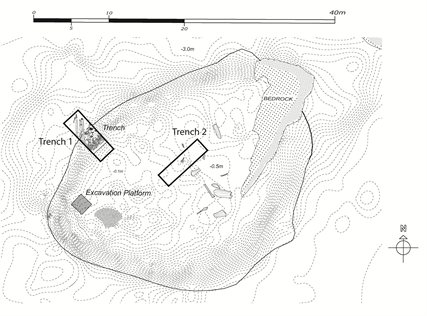Ederline Boathouse in Loch Awe is located at the south-western end of Loch Awe, Scotland, and is visible in the summer months as a grass-covered stony mound above the water.
This small mound of about four metres in diameter represents only a small fraction of the true extent of the submerged site. Ederline is unusual in that it is one of a minority of crannogs which utilise a natural bedrock outcrop as a foundation.
The crannog was examined by McArdle and McArdle in the early-1970s as part of the first complete underwater crannog survey of any loch in Scotland, and was further examined by Morrison in the 1980s. There are numerous structural timbers protruding from the site, principally on the surface of the crannog in less than a metre of water. McArdle and McArdle recorded a large number of oak structural timbers back in 1972, as well as two saddle querns and a rotary quern, all of which were left in situ on the site, while Morrison sampled one of the oak vertical piles from the site in 1982, which was radiocarbon dated to 400-190 BC.
In 2004 and 2006-2007, underwater excavations were carried out by UARC to gather data and to identify whether significant organic deposits were preserved on the site. Despite the radiocarbon determination obtained by Morrison in 1982, our excavations revealed two sherds of E-ware in a sealed organic context suggesting an early historic date for this deposit signposting the complex stratigraphy and long-lived significance of the site.
Two trenches were excavated to loch bed level in about three metres of water. Well-preserved organic deposits were encountered, along with numerous structural timbers and a large animal bone assemblage (consisting mainly of pig and cattle bones).
In ‘Trench One’, excavated on the northern side of the site, the deposits represent discard from occupation taking place higher up on the main mound including significant amounts of animal bone, woodchips, a rotary quern stone, two sherds of E-ware dating to the Early Historic period, and mortised timber.
In ‘Trench Two’ on the upper surface of the mound, we excavated horizontal timbers within an organic matrix, which are consistent with the expected characteristics of 'packwerk' foundation deposits, where timbers are laid in layers to create an artificial mound. As a result these deposits are likely to contain material related to the construction of the site, and not to its domestic occupation. It therefore remains a possibility that the occupation on top of the mound has been eroded away, leaving only the upper log platform structural layers of a 'packwerk' type construction; the small pieces of burnt bone and charcoal that were found overlaying the 'packwerk' deposits supports this view, as it is possible that this deposit represents the eroded remains of domestic occupation atop the mound.

Project results
One of the most important results of the Ederline excavations was the production of an accurately recorded stratigraphy of the submerged deposits encountered on the site.
It is relatively common to observe exposed organic deposits on submerged crannogs without the need for excavation, but detailed description of these deposits and accurate records of their stratigraphic relationships have been greatly lacking from crannog studies in general.
The information obtained has been extremely informative in the context of crannog studies and has challenged the validity of dating these sites from just one radiocarbon determination obtained from one part of the site. In fact, to date no crannog that has been subject to any level of excavation has provided evidence of a single phase occupation. Further excavation at the site has the potential to shed further light on the processes of crannog construction and taphonomy, as well as on the way in which crannogs developed as settlements through the Iron Age and Early Historic periods.
Selected publications and recordings from the project:
- Original Loch Awe Crannog Survey 1972
- Site record for Ederline Crannog
- HENDERSON, J.C., 2012. Meeting Expectations? The underwater investigation of Scottish lake dwellings.. In: HENDERSON, J.C., ed., Beyond Boundaries: The 3rd International Congress on Underwater Archaeology, IKUWA 3 London 2008 Römisch-Germanische Kommission. 377-390
- HENDERSON, J.C., 2007. Recognising complexity and realizing the potential of Scottish Crannogs In: Archaeology From The Wetlands. 231-241
- CAVERS, M. G. and HENDERSON, J. C., 2005. Underwater excavation at Ederline Crannog, Loch Awe, Argyll, Scotland International Journal of Nautical Archaeology. 34(2), 282-298